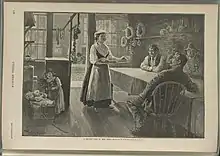Sicilian Americans
Sicilian Americans (Italian: Siculoamericani; Sicilian: Siculu-miricani) are Americans of Italian Sicilian birth or ancestry. They are a large ethnic group in the United States.[2]
| Total population | |
|---|---|
| 85,175 (2000 American Community Survey)[1] | |
| Regions with significant populations | |
| New York City, New Haven, Buffalo, Rochester, Erie, Tampa, Pittsburgh, Chicago, Boston, Pittston, Johnston, Rhode Island, Detroit, Philadelphia, Los Angeles, San Francisco, New Orleans, Milwaukee, Birmingham | |
| Languages | |
| American English • Italian • Sicilian | |
| Religion | |
| predominantly Roman Catholic | |
| Related ethnic groups | |
| Italian Americans • Italian Canadians • Italian Australians • Maltese Americans • Italians (Sicilians) |
History

Sicilian emigration to the US grew substantially starting in the 1880s to 1914, when it was cut off by the World War. Many Sicilians planned to return home after a few years making money in the United States, but the wartime delay allowed many to assimilate into better jobs and wartime experience, so they did not return. By 1924, about 4,000,000 Sicilians emigrated to the US, And several million returned.[3] The Emergency Quota Act, and the subsequent Immigration Act of 1924 sharply reduced immigration from Southern Europe except for relatives of Sicilians already in the U.S.[4] This period saw political and economic shifts in Sicily that made emigration desirable. There was also a large wave of immigration after World War II. A great portion of the Sicilian immigrants would settle in New York City, New Jersey, New Haven, Buffalo, Rochester, Erie, Tampa, Pittsburgh, Chicago, Boston, Pittston, Johnston, Rhode Island, Detroit, Philadelphia, Los Angeles, San Francisco, New Orleans, Milwaukee, and Birmingham.
Culture
Sicilian immigrants brought with them their own unique culture, including theatre and music. Giovanni De Rosalia was a noted Sicilian American playwright in the early period and farce was popular in several Sicilian dominated theatres. In music Sicilian Americans would be linked, to some extent, to jazz. Many of the more popular cities for Sicilian immigrants, like Brooklyn, New Orleans or Chicago, are pivotal in the history of jazz. In Brooklyn the predominantly Sicilian neighborhoods were Bensonhurst and Gravesend, In Chicago "Little Sicily" and in New Orleans it was "Little Palermo." One of the earliest, and among the most controversial, figures in jazz was Nick LaRocca, who was of Sicilian heritage. Modern Sicilian American jazz artists include Bobby Militello and Chuck Mangione.[5]
.tiff.jpg.webp)
In 1892 Mother Cabrini arrived in New Orleans and opened an orphanage which became Cabrini High School in 1959.[6]
The Sicilian-American respect for San Giuseppe (St. Joseph) is reflected in the celebration of the Feast of St. Joseph, primarily in New Orleans and Buffalo, every March 19. Many families in those cities prepare a "St. Joseph's Day table", at which relatives or neighbors portray Jesus, Joseph and Mary and oversee the serving of meat-free Lenten meals to the poor of the community. The tables are the vestiges of a Sicilian legend which states that farmers prayed to St. Joseph, promising that if he interceded in a drought, they would share their bounty with the poor. The foods served at such tables include: Pasta con le sarde (spaghetti with sardines); lenticchie (lentils); and various froscie (omelettes) made with cardoon (wild artichoke), cicoria (dandelion) and other homely vegetables. Desserts include sfingi, zeppoli, a light puff pastry; sfogliatelle, pignolati, struffoli (honey balls); and cannoli, a Sicilian creation. One tradition has each guest at a St. Joseph's Day table receiving a slice of orange, a bit of fennel and a fava bean, for good luck.[7]
Notable people
See also
References
- "Table 1. First, Second, and Total Responses to the Ancestry Question by Detailed Ancestry Code: 2000" (XLS). U.S. Census Bureau. Retrieved December 2, 2010.
- Laura C. Rudolph, "Sicilian Americans."
- "Destination America . When did they come? | PBS". www.pbs.org. Retrieved 2019-09-25.
- "Who Was Shut Out?: Immigration Quotas, 1925-1927". historymatters.gmu.edu. Retrieved 2016-08-15.
- Laura C. Rudolph, "Sicilian Americans."
- https://neworleanshistorical.org/items/show/226
- Laura C. Rudolph, "Sicilian Americans."
Further reading
- Gabaccia, Donna. From Sicily to Elizabeth Street (State University of New York Press, 1984).
- Gabaccia, Donna. Militants and Migrants: Rural Sicilians Become American Workers (Rutgers University Press, 1988).
- Mazzucchelli, Chiara. “Heart of My Race”: Questions of Identity in Sicilian/American Writings (Florida Atlantic University Press, 2007).
- Raab, Selwyn. Five Families: The Rise, Decline, and Resurgence of America's Most Powerful Mafia Empires (St. Martin's Press, 2005_.
- Rudolph, Laura C. "Sicilian Americans." in Gale Encyclopedia of Multicultural America, edited by Thomas Riggs, (3rd ed., vol. 4, Gale, 2014, pp. 151-163). Online
- Schiavelli, Vincent. Bruculinu, America: Remembrances of Sicilian-American Brooklyn (1998).